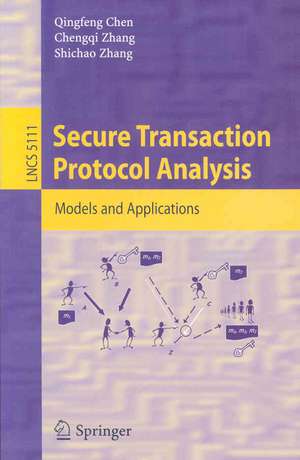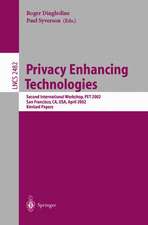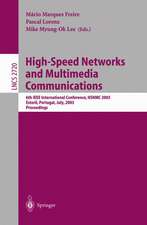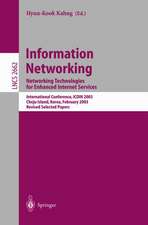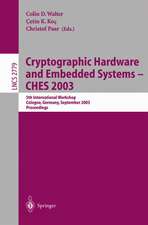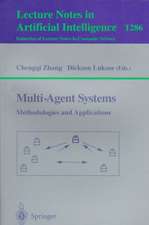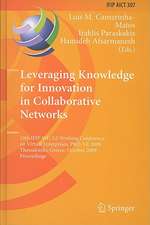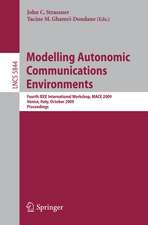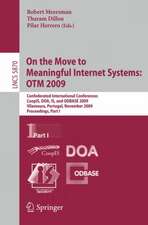Secure Transaction Protocol Analysis: Models and Applications: Lecture Notes in Computer Science, cartea 5111
Autor Qingfeng Chen, Chengqi Zhang, Shichao Zhangen Limba Engleză Paperback – 30 iul 2008
Din seria Lecture Notes in Computer Science
- 20%
 Preț: 1061.55 lei
Preț: 1061.55 lei - 20%
 Preț: 307.71 lei
Preț: 307.71 lei - 20%
 Preț: 438.69 lei
Preț: 438.69 lei - 20%
 Preț: 645.28 lei
Preț: 645.28 lei -
 Preț: 410.88 lei
Preț: 410.88 lei - 15%
 Preț: 580.46 lei
Preț: 580.46 lei - 17%
 Preț: 427.22 lei
Preț: 427.22 lei - 20%
 Preț: 596.46 lei
Preț: 596.46 lei -
 Preț: 449.57 lei
Preț: 449.57 lei - 20%
 Preț: 353.50 lei
Preț: 353.50 lei - 20%
 Preț: 1414.79 lei
Preț: 1414.79 lei - 20%
 Preț: 309.90 lei
Preț: 309.90 lei - 20%
 Preț: 583.40 lei
Preț: 583.40 lei - 20%
 Preț: 1075.26 lei
Preț: 1075.26 lei - 20%
 Preț: 310.26 lei
Preț: 310.26 lei - 20%
 Preț: 655.02 lei
Preț: 655.02 lei - 20%
 Preț: 580.93 lei
Preț: 580.93 lei - 20%
 Preț: 340.32 lei
Preț: 340.32 lei - 18%
 Preț: 938.83 lei
Preț: 938.83 lei - 20%
 Preț: 591.51 lei
Preț: 591.51 lei - 15%
 Preț: 438.59 lei
Preț: 438.59 lei - 20%
 Preț: 337.00 lei
Preț: 337.00 lei -
 Preț: 389.48 lei
Preț: 389.48 lei - 20%
 Preț: 607.39 lei
Preț: 607.39 lei - 20%
 Preț: 1024.44 lei
Preț: 1024.44 lei - 20%
 Preț: 579.30 lei
Preț: 579.30 lei - 20%
 Preț: 763.23 lei
Preț: 763.23 lei - 20%
 Preț: 453.32 lei
Preț: 453.32 lei - 20%
 Preț: 575.48 lei
Preț: 575.48 lei - 20%
 Preț: 585.88 lei
Preț: 585.88 lei - 20%
 Preț: 825.93 lei
Preț: 825.93 lei - 20%
 Preț: 763.23 lei
Preț: 763.23 lei - 17%
 Preț: 360.19 lei
Preț: 360.19 lei - 20%
 Preț: 1183.14 lei
Preț: 1183.14 lei - 20%
 Preț: 340.32 lei
Preț: 340.32 lei - 20%
 Preț: 504.57 lei
Preț: 504.57 lei - 20%
 Preț: 369.12 lei
Preț: 369.12 lei - 20%
 Preț: 583.40 lei
Preț: 583.40 lei - 20%
 Preț: 343.62 lei
Preț: 343.62 lei - 20%
 Preț: 350.21 lei
Preț: 350.21 lei - 20%
 Preț: 764.89 lei
Preț: 764.89 lei - 20%
 Preț: 583.40 lei
Preț: 583.40 lei - 20%
 Preț: 649.49 lei
Preț: 649.49 lei - 20%
 Preț: 341.95 lei
Preț: 341.95 lei - 20%
 Preț: 238.01 lei
Preț: 238.01 lei - 20%
 Preț: 538.29 lei
Preț: 538.29 lei
Preț: 330.42 lei
Preț vechi: 413.03 lei
-20% Nou
Puncte Express: 496
Preț estimativ în valută:
63.22€ • 66.19$ • 52.32£
63.22€ • 66.19$ • 52.32£
Carte tipărită la comandă
Livrare economică 07-21 aprilie
Preluare comenzi: 021 569.72.76
Specificații
ISBN-13: 9783540850731
ISBN-10: 3540850732
Pagini: 248
Ilustrații: XI, 234 p.
Dimensiuni: 155 x 235 x 13 mm
Greutate: 0.36 kg
Ediția:2008
Editura: Springer Berlin, Heidelberg
Colecția Springer
Seriile Lecture Notes in Computer Science, Programming and Software Engineering
Locul publicării:Berlin, Heidelberg, Germany
ISBN-10: 3540850732
Pagini: 248
Ilustrații: XI, 234 p.
Dimensiuni: 155 x 235 x 13 mm
Greutate: 0.36 kg
Ediția:2008
Editura: Springer Berlin, Heidelberg
Colecția Springer
Seriile Lecture Notes in Computer Science, Programming and Software Engineering
Locul publicării:Berlin, Heidelberg, Germany
Public țintă
ResearchCuprins
Overview of Security Protocol Analysis.- Formal Analysis of Secure Transaction Protocols.- Model Checking in Security Protocol Analysis.- Uncertainty Issues in Secure Messages.- Applications of Data Mining in Protocol Analysis.- Detection Models of Collusion Attacks.- Conclusion and Future Works.
Textul de pe ultima copertă
The present volume arose from the need for a comprehensive coverage of the state of the art in security protocol analysis. It aims to serve as an overall course-aid and to provide self-study material for researchers and students in formal methods theory and applications in e-commerce, data analysis and data mining. The volume will also be useful to anyone interested in secure e-commerce.
The book is organized in eight chapters covering the main approaches and tools in formal methods for security protocol analysis. It starts with an introductory chapter presenting the fundamentals and background knowledge with respect to formal methods and security protocol analysis. Chapter 2 provides an overview of related work in this area, including basic concepts and terminology. Chapters 3 and 4 show a logical framework and a model checker for analyzing secure transaction protocols. Chapter 5 explains how to deal with uncertainty issues in secure messages, including inconsistent messages and conflicting beliefs in messages. Chapter 6 integrates data mining with security protocol analysis, and Chapter 7 develops a new technique for detecting collusion attack in security
protocols. Chapter 8 gives a summary of the chapters and presents a brief discussion of some emerging issues in the field.
The book is organized in eight chapters covering the main approaches and tools in formal methods for security protocol analysis. It starts with an introductory chapter presenting the fundamentals and background knowledge with respect to formal methods and security protocol analysis. Chapter 2 provides an overview of related work in this area, including basic concepts and terminology. Chapters 3 and 4 show a logical framework and a model checker for analyzing secure transaction protocols. Chapter 5 explains how to deal with uncertainty issues in secure messages, including inconsistent messages and conflicting beliefs in messages. Chapter 6 integrates data mining with security protocol analysis, and Chapter 7 develops a new technique for detecting collusion attack in security
protocols. Chapter 8 gives a summary of the chapters and presents a brief discussion of some emerging issues in the field.
